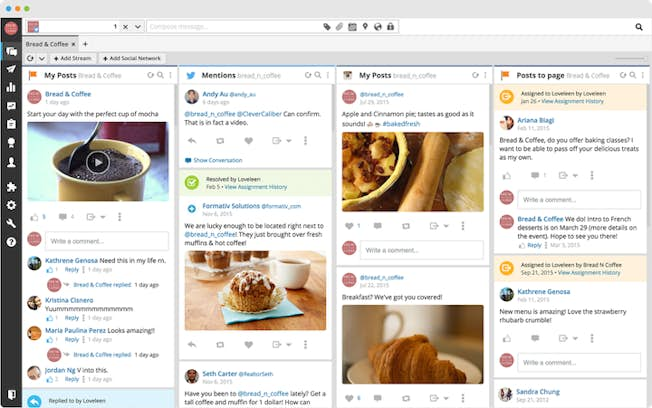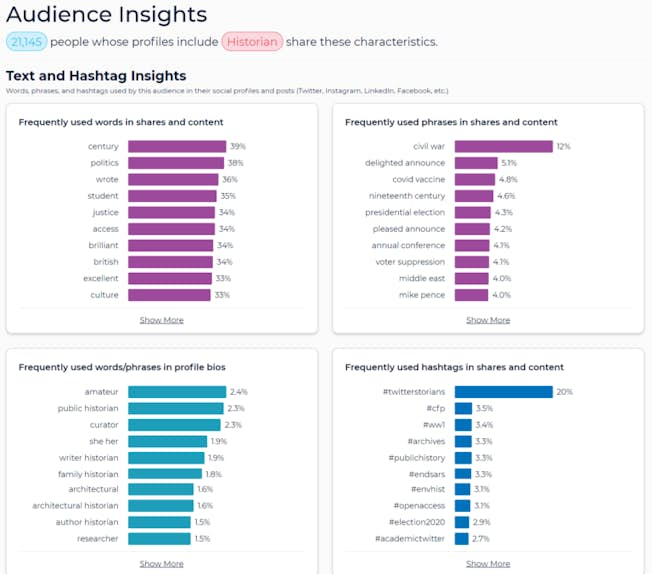Feb 14, 2023
Be Quiet & Listen: How & Why Your Brand Should Use Social Listening
I’ll bet your friends listen to you. No doubt your favorite boss listens too. Then why do brands think it’s okay to use their social channels to keep talking and pushing, ignoring customers’ needs, and (dare we say it)... their complaints and bad reviews?
That can’t happen anymore if you want to be successful. The benefits of social listening go far beyond customer satisfaction.
A carefully-constructed social listening strategy can help boost your brand’s reputation, bring in more recommendations (word-of-mouth advertising), help identify new USPs and allow you to track competitor’s activity with ease.
Remember, when customers feel connected to a brand, 57 percent will increase their spending and 76 percent will purchase from them over a competitor, according to Sprout Social research.
Find out how to create a killer social listening strategy that can transform your business and propel your brand miles ahead of your competition.
What is social or audience listening?
If you want to define it, audience listening is the process of monitoring what people say on digital media channels about your brand, your products, or your competitors.
You can use audience listening to gain a better understanding of your audience and their needs or desires. It’s a quick and easy method of getting specific insights into your existing and prospective customers and delving deeper into your audience research.
It can also help you create meaningful and sustainable long-term relationships with your audience members.
One of the most common and effective ways to conduct audience listening is to monitor conversations on social media channels. This is known as social listening.
Every day people discuss your brand or topics that relate to your industry so it’s wise to keep track of what’s being said. Understanding this will help you to create better content, build better audience personas, and devise better digital strategies.
What are the benefits of social listening?
There are many benefits to using audience listening in your marketing activities. It will help you to
- Stay on top of developments in your market to strengthen industry knowledge - this is particularly important for B2B marketers
- Track what people are saying about your brand on social media and other online channels like websites, blogs, and news articles
- Monitor competitor mentions, updates, and announcements online
- Develop new ideas for your content, messaging, and campaigns
- Understand the needs and motivations of your audience and enhance customer service
- Adapt products, services, and propositions to suit existing and emerging customer needs
- Build a rapport with your audience and cultivate a meaningful and long-term relationship
- Help you react and prepare for a social media crisis or brand incident (more on that later!)
How to listen like a pro
According to Statista, 36 percent of customers in the U.S. cite “great customer service” as a motivation to recommend a brand online. So it’s worth using social monitoring to see how your brand is perceived in the consumer ecosphere.
Here are six steps that will help you listen like a pro!
Step 1 – Identify what to listen out for
Step 2 - Use social listening tools
Step 3 – Spy on your competitors
Step 4 – Learn how to respond to comments, compliments, and complaints
Step 5 – Take notes
Step 6 – Take action
It’s that simple. Let’s look at each step in more detail.
1. Identify what to listen out for
The first thing you need to do (once you know and have a handy buyer persona breakdown) is to identify what your social listening strategy is trying to achieve – the ‘what’ and ‘why’.
Your social listening objectives should align with your overall digital marketing strategy. Examples of what you can monitor in your social listening are:
- Brand mentions
- Industry developments or innovations
- Identify and follow competitors
- Customer feedback - complaints, compliments, and otherwise
- Selected keywords (here are some great free keyword research tools to help)
- Topics related to your company or industry
- Relevant and targeted hashtags
- Discussion groups - LinkedIn, Reddit, Facebook, or Google groups
Tracking a few or all of these will give you insight into your audience, your industry, and your competitors. This will help you to craft better content and use channels to raise brand awareness and drive engagement.
“Most of what we do as market researchers is ask, right? What's really nice about social data is that it is unasked. That is just what people feel like talking about around the topic. And that is very essential to know what is organic.” says Katrina Noelle, Founder of KNow Research in our podcast.
2. Use social listening tools
There are many different audience listening tools on the market. Let’s look at five of the most popular for your business.
Hootsuite

With Hootsuite, you can manage multiple social accounts at once with a single dashboard which makes it easy to listen to all your networks at once.
This tool lets you monitor brand mentions, track keyword usage, view and respond to messages, and follow influencer accounts. You can also create influencer and lead lists and access analytics reports to measure progress, allow for post-scheduling and provide training through Hootsuite University.
Plans start from $49 per month but you can upgrade to team or business accounts for more features.
Google Alerts
The big appeal of Google Alerts is its scope. It monitors all web content to search for your chosen search terms, which includes everything from web pages to blogs, news articles, scientific research, and much more.
Another benefit is that you can set up alerts for any term or phrase. This allows you to monitor products, services, brand mentions, competitors or keywords. You can also set the frequency for how often you'll receive email alerts, allowing you to keep close tabs on what's being said about you.
Brandwatch
Brandwatch is a social media analytics tool that tracks billions of online conversations from blogs, forums, news, forums, videos, images, and social feeds.
A consumer intelligence and social media management platform, it lets you track mentions and keywords in real-time. The tool also uses Image and sentiment analysis as an added feature.
This will help you to access consumer insights, trends, brand perception, and influencers.
Sparktoro

Set up by Moz’s founder, Rand Fishkin, SparkToro is marketed as “an audience research tool that shows the websites your customers visit, social accounts they follow, hashtags they use, and more — so you can do marketing that works.”
It works by crawling over 80 million profiles across billions of web pages, social media profiles, podcasts, and YouTube channels. This will help you find out what and who your audience listens to, reads, watches, follows, and shares online.
SparkToro has a free plan and upgraded plans with access to more features up to the agency level.
Mention
Mention can monitor billions of web pages in 42 different languages. It has a competitive analysis tool and a crisis management feature to get ahead of any possible bad publicity or issues down the line.
Tip: If you don’t have the budget for a paid tool, you can gain insights through observational social listening. Look at your social channels, emails, and phone calls, and set up Google Alerts for brand mentions. Make a list of common keywords and phrases to understand patterns and discover more about consumer sentiment and attitude.
3. Spy on your competitors
It’s always wise to keep an eye on your competitors to find out what they are doing, especially if they’re creating a buzz or driving engagement.
You can do this by using social media metrics and social intelligence tools. Pay attention to your competitors’ most engaging content types and themes, conversations, promotions, and posting times.
What you're looking for with these tools is not only the basic numbers - followers, likes, etc - but also the content that your competitors share that resonates with audiences.
Common social media tools you can use for competitive research (on top of the ones listed above) include:
- Sprout Social
- Determ
4. Learn how to respond to comments, compliments & complaints
If you’re setting up social listening to monitor mentions, there’s no point in ignoring what your customers are saying; both good and bad.
Every business has got a bad review at some point or maybe even a fake one, but it’s how you deal with it that makes your brand stand out.
If you’re looking at a complaint or someone venting about your product or service, reach out. Start with an apology such as ‘I’m sorry you’re having this experience’ and then deal head-on with the issue raised. Offer to have a discussion to resolve it, a private chat via WhatsApp or other channels. Show that you care and want to do your best to keep them as a customer.
For comments on social media, it’s important to respond quickly. If it’s a positive tweet or post then express your thanks and add personalization if the comment allows it. For negative comments, again thank them for taking the time to comment but offer them the chance to talk to someone or reach out with more details so you can help solve the issue.
Tip: Find out how to use direct messaging in your marketing activities by reading ‘WhatsApp Marketing: What You Need to Know’.
5. Take notes
It’s important to keep track of interactions to gain insights into your audience but also your feedback.
Set up a spreadsheet and make it someone’s responsibility to keep updated. This could be a member of your marketing or customer service team as decided when you set up your social media style guide and routine.
Take note of each comment type – e.g. one for compliments and one for complaints. Then each time you receive a comment worth noting you can pop it into your doc in the appropriate section.
As Katrina Noelle says: “It's a question of what your social data is telling you. So, if we start a relationship with a brand; What are you learning there? What can we use and learn from it to make our work more targeted?”
Read: ‘How to Manage Online Customer Reviews’ for more information in this area.
6. Take action
Take out your updated spreadsheet on a weekly or monthly basis and look at each tab with a fresh eye. Is there a consistent theme that is emerging in your complaints or a pattern you can see that could help you craft better content or improve a service?
If so, you should address this with your customer service team and discuss whether you can come up with a sustainable solution to tackle the issues customers are facing. You can always reach out via a poll on social media or through an email campaign to get further feedback.
This is also a great time to take screenshots of your social compliments and positive feedback – these can be used to add credibility to future marketing materials like sales collateral and even website copy.
Great brand examples of social listening
Any brand that wants to build a good relationship with customers and provide great customer service uses social listening. Here are four great examples from big brands that you can take inspiration from.
1. Fitbit
The well-known creator of wearable health devices, Fitbit focuses on building a community among its customers. The brand also uses humor and jumps on trends to engage customers and show its personality.
This tweet below is Fitbit’s reaction to a tweet showing the tracks of a bird in the snow (on a picture that originally got 22.4k views) with the caption ‘Looks like someone got a fitbit from Santa’.

They also regularly share comments from customers, funny gifs related to their products, and media stories that feature their products or employees. Their dedicated @FitBitSupport feed is focused on responding to queries or issues. Plus, they have accounts for different locations and territories to provide localized support.
Using social listening and being proactive on social media allows the brand to build a loyal customer base, deal with queries quickly and engage people across all walks of life.
2. Netflix
Streaming superstar, Netflix has the perfect product to engage customers - entertainment in many categories. It uses social media channels to promote new shows and their stars.
On its YouTube channel @stillwatchingnetflix, with over 5 million subscribers (the main channel has nearly 26 million subscribers), they dig deeper into its shows by promoting interviews with actors (see the best friends challenge with the Lockwood & Co cast) or getting reactions from others on shows like the drag queens Trixie Mattel and Katya.
They also have a @NetflixGeeked on Twitter to engage with fans of shows and drive their authority in the area of entertainment. It also provides an opportunity to promote their back catalog and get new fans for shows on their channel.
3. Chipotle
Mexican fast food chain Chipotle makes waves on social media. It uses social listening to understand what its customers like and asks for feedback on its channels on a regular basis.
This simple video on Chipotle's TikTok asking people what utensil they preferred to use got nearly 4,000 views and 260 comments.
They also share the secrets to their recipes on the social channel featuring one of their chefs and share user-generated content along with new menu items that generate feedback. Their mystery box campaign creates buzz and encourages customers to share their unboxing across social media.
Social listening helps Chipotle to find out who is talking about its brand and identify content creators that are advocates. The Cheeky Boys were challenged by the brand to send a burrito to space which resulted in a great video.
Tip: Find out ‘How To Go Viral On Tik Tok: Tips from Top Accounts’ to get ideas for their channel.
4. Slack
Messaging app Slack is known for its popularity in the business communications realm but uses social listening to jump on trends or comment on topics that are relevant to the brand.
Just because they are a B2B business doesn’t mean they have to be boring! The brand uses humor to engage followers and runs polls to get insights into the needs and desires of its customers.
This tweet focuses on what Slack is all about - enabling communication. The article pictured is from a Wall Street Journal article that features their Senior Director of Product.

They also have a Slack Status channel to provide updates on the platform and report on any delays or issues. This provides a way for customers to see what’s going on and also interact with the company.
How to deal with a crisis using social listening
When it comes to dealing with negative feedback or even a possible crisis, social listening can help you find out what’s being said and get ahead of the problem.
In some cases, social listening may be the first indicator of something being wrong with one of your products or a major brand incident. So set up alerts that will notify a specific group of people trained to deal with this.
When an issue does occur, follow the three A’s.
- Acknowledge - The first is to acknowledge the issue, internally and publicly. Do not stop social interactions or hide away. Get in front of it and show you are working to resolve it.
- Apologize - Depending on the situation, craft an apology that’s authentic and human-led. Avoid corporate speak as customers will think you’re just going through the motions. Lead with a human voice and consider bringing in a senior member of the team to comment if required through a video or statement.
- Address - Irrelevant of the crisis, an apology alone will never be enough. Customers and the wider public want to know how you are going to resolve the issue and assure them that a similar crisis will be avoided in the future.
If you want more detailed guidance in this area download ‘The DMI Guide to Social Media Crises’.
Use social listening to know your customers better
Social media provides marketers and companies with a wealth of information about their customers and brand. The challenge is knowing how to use each platform effectively and analyzing the data to drive business insights. DMI’s social media marketing course provides a working knowledge of all the biggest social media platforms (Facebook, TikTok, Instagram, and YouTube) along with diving into social content, strategy, and social commerce.
Related
Upgrade to Power Membership to continue
your access to thousands of articles, toolkits, podcasts, lessons and much much more.
Become a Power Member- Login
- View Courses
- - - -
- Courses
- Resources
- - - -
- My Account
- Change Password
- Logout






